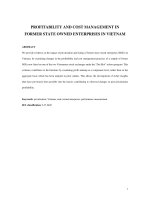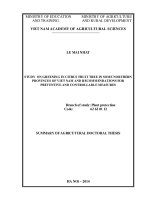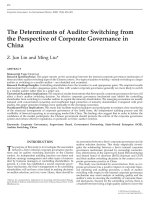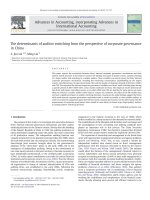Corporate governance in Vietnam and in state owned enterprises after equitization = Quản trị doanh nghiệp ở Việt Nam và tại các doanh nghiệp nhà nước sau cổ phần hóa
Bạn đang xem bản rút gọn của tài liệu. Xem và tải ngay bản đầy đủ của tài liệu tại đây (707.85 KB, 90 trang )
vietnam national university, HANOI
school of business
Do Lan Huong
Corporate governance in Vietnam and in state owned
enterprises after equitization
Major: Business Administration
Code: 60 34 05
Master of business administration thesis
Supervisor: Dr Can Van Luc
Hanoi – 2010
i
ACKNOWLEDGEMENT
I would like to deeply thank my parents who have encouraged me in my
education and their constant support through the course of studies.
I also would like to thank my husband and my 2 little sons for their
encouragement to me to continue my education.
Many thanks also go to my colleagues who helped me a lot in collecting data
to finish the thesis.
Especially, I would like to send my sincere thanks to my helpful supervisor
Dr. Can Van Luc, for his advice and support during the time I write the thesis.
ii
ABSTRACT
CORPORATE GOVERNANCE IN VIETNAM
AND
IN STATE OWNED ENTERPRISES AFTER EQUITIZATION
Do Lan Huong
Hanoi School of Business
Supervisor: Dr. Can Van Luc
September 2010, 85 pages
Corporate governance has been a prominent issue in developed
market economies for some considerable time. However, in an emerging and
transition economy like Vietnam, it is still unfamiliar and underdeveloped.
Legal framework for corporate governance in Vietnam is only in the early
stage of development. Awareness of market participants on corporate
governance is still limited. In the meantime, the business environment and the
capital market are changing very fast and becoming more and more
complicated, especially after the world financial crisis in 2007-09. The recent
break up of Vinashin and the alarming inefficiency in management and
operation of state owned enterprises have also attracted attention to corporate
governance and made it become one of the current hottest issues.
In this context, this thesis provides a literature review of corporate
governance and an up-to-date evaluation of corporate governance practices in
Vietnam. Besides, as the success of Vietnam‟s SOE reform through
equitization is significant for the country‟s future economic growth and the
improvement in corporate governance is one of the major factors for
improving efficiency in equitized state-owned enterprises (SOEs), an
examination of the changes in corporate governance of SOEs after equitization
is also conducted. To conclude, the thesis provides recommendations to
building a sound and strong corporate governance system in Vietnam.
iii
TÓM TẮT
QUẢN TRỊ DOANH NGHIỆP Ở VIỆT NAM
VÀ
TẠI CÁC DOANH NGHIỆP NHÀ NƯỚC SAU CỔ PHẦN HÓA
Đỗ Lan Hương
Khoa Quản trị kinh doanh
Giáo viên hướng dẫn: TS. Cấn Văn Lực
Tháng 09 năm 2010, 71 trang
Ở các nước phát triển, quản trị doanh nghiệp đã ra đời từ lâu và rất
được quan tâm. Tuy nhiên, ở các nền kinh tế mới nổi và đang trong giai đoạn
chuyển đổi như Việt Nam, quản trị doanh nghiệp vẫn còn là một khái niệm
mới mẻ và chưa được phát triển. Khung pháp lý cho quản trị doanh nghiệp đã
được xây dựng nhưng vẫn còn ở giai đoạn ban đầu. Nhận thức về quản trị
doanh nghiệp của các bên tham gia thị trường còn nhiều hạn chế. Trong khi
đó, môi trường kinh doanh cũng như thị trường vốn đang thay đổi hết sức
nhanh chóng và ngày càng trở nên phức tạp đặc biệt sau cuộc khủng hoảng tài
chính toàn cầu năm 2007-09. Bên cạnh đó, vụ việc Vinashin mới đây cũng
như sự thiếu hiệu quả đáng báo động trong quản lý ở các doanh nghiệp Nhà
Nước cũng làm dấy lên sự chú ý của mọi người tới quản trị doanh nghiệp và
khiến nó trở thành một trong những vấn đề nóng bỏng nhất hiện nay.
Trên tinh thần đó, luận văn đề cập đến hệ thống cơ sở lý luận về quản
trị doanh nghiệp và bức tranh cập nhật nhất về thực trạng quản trị doanh
nghiệp ở Việt Nam. Bên cạnh đó, do sự thành công trong công cuộc đổi mới
doanh nghiệp nhà nước (DNNN) thông qua quá trình cổ phần hóa có ý nghĩa
rất quan trọng tới sự phát triển kinh tế trong tương lai của Việt Nam, nên luận
văn cũng sẽ trao đổi về quản trị DNNN sau cổ phần hóa. Trong phần cuối,
luận văn đưa ra một số kiến nghị nhằm góp phần xây dựng và nâng cao hiệu
quả công tác quản trị doanh nghiệp tại Việt Nam.
iv
TABLE OF CONTENTS
ACKNOWLEDGEMENT i
ABSTRACT ii
TÓM TẮT iii
TABLE OF CONTENTS iv
LIST OF ABBREVIATIONS vi
LIST OF TABLES vii
CHAPTER 1: INTRODUCTION 8
1.1 Background 8
1.2 Rationale of the Thesis 9
1.3 Purpose of the Thesis 9
1.4 Key Research Area 10
1.5 Methodology 10
1.6 Contribution of the Thesis 10
1.7 Outline 11
CHAPTER 2: LITERATURE REVIEW 12
2.1 Definitions of Corporate Governance 12
2.1.2 What is Corporate Governance? 12
2.1.2 Objectives of Corporate Governance 12
2.1.2 Codes of Corporate Governance 13
2.2 Models of Corporate Governance 14
2.2.1 Shareholder Model 14
2.2.1 Stakeholder Model 15
2.3 Corporate Governance System 17
2.4 Corporate Governance Mechanisms 19
2.4.1 Internal Mechanisms 20
2.4.2 External Mechanisms 25
2.5 Corporate Governance in Transition Economies 28
2.6 Chapter Summary 31
CHAPTER 3: CORPORATE GOVERNANCE IN VIETNAM 32
3.1 Introduction 32
3.2 Legal framework and law enforcement 33
3.2.1 Development of a legal framework for corporate governance in Vietnam
33
3.2.2 Current corporate governance framework in Vietnam 34
3.3 Rights of Shareholders 39
3.3.1 Basic shareholder rights 39
3.3.2 Right to participate in or to be informed of decisions on key corporate
changes 42
3.3.3 Rights to participate and vote in general shareholders‟ meeting 43
3.3.4 Markets for corporate control 44
3.4 Equitable Treatment of Shareholders 45
3.4.1 Equal treatment to all shareholders 45
3.4.2 Minority shareholder protection 46
3.4.3 Insider trading and abusive self-dealing 48
3.4.4 Related party transactions 48
3.5 The Role of Stakeholders in Corporate Governance 49
3.6 Disclosure and Transparency 49
v
3.6.1 Information disclosure 50
3.6.2 Quality of accounting standards 52
3.6.3 Annual audit 53
3.6.4 External Audit 55
3.6.5 Channels for disseminating information 56
3.7 Board of Directors 57
3.8 Board of Supervisors 62
3.9 Remaining corporate governance issues in Vietnam 63
3.10 Chapter Summary 64
CHAPTER 4: CHANGES IN CORPORATE GOVERNANCE OF STATE OWNED
ENTERPRISES AFTER EQUITIZATION 66
4.1 Introduction 66
4.2 Methodology and Data collection 67
4.3 Ownership structure after equitization 68
4.4 Board of Directors Composition 69
4.5 The Board of Supervisors 70
4.6 Manager orGeneral manager (CEO) 72
4.7 Other committees 73
4.8 Executive Compensation 73
4.9 Case Study 73
4.9.1 Vinamilk 74
4.9.2 PVFCCo 77
4.9.3 Performance and stock price comparison 80
4.10 Chapter Summary 81
CHAPTER 5: CONCLUSIONS AND RECOMMENDATIONS 82
REFERENCES 85
vi
LIST OF ABBREVIATIONS
BOD: Board of Directors
GSM: General Shareholders Meeting
SOE: State owned enterprises
SSC: State Securities Commission
HOSE: Ho Chi Minh Stock Exchange
HASTC: Ha Noi Stock Trading Center
HNX: Ha Noi Stock Exchange
OECD: Organization for Economic Cooperation and Development
CFA: Chartered Financial Analysts
LLC: Limited Liability Company
JSC: Joint Stock Company
vii
LIST OF TABLES
Table 4.1: Ownership structure of SOEs after equitization
Table 4.2: Composition of Board of Directors
Table 4.3: Distribution of chairperson of the BOD by different groups of
shareholders
Table 4.4: Composition of the Board of Supervisors
Table 4.5: Chairperson of the Board of Supervisors by different groups of
shareholders
Table 4.6: Distribution of managers of surveyed firms by different groups of
shareholders
Table 4.7: Vinamilk Ownership structure in 2009
Table 4.8: PVFCCo Ownership structure in 2009.
8
CHAPTER 1: INTRODUCTION
1.1 Background
Vietnam‟s stock market has only been established and developed for the last
ten years. However, it has grown very fast and now plays a more and more
important role to the country‟s economic development. Total market capitalization
to GDP increased considerably from 3% in 2005 to 38% in 2009. Number of
companies listed in 2 stock exchanges (Ho Chi Minh Stock Exchange and Ha Noi
Stock Exchange) has also increased dramatically to 457 companies by the end of
2009. Among which, equitized state-owned enterprises (SOEs) dominate with more
than half of the listed companies and holding key industries including power, oil,
chemicals, steel…etc.
Like many other emerging markets, Vietnam‟s stock market is facing many
agency problems, which are the subject of corporate governance. Investor
protection is inadequate, related party transactions are pervasive, compliance with
accounting standards is weak and disclosure of quality information is limited. These
could be major reasons that foreign investors hesitate to invest in Vietnam and
hinder the development of the capital market.
In Vietnam, corporate governance is still underdeveloped. Awareness of
market participants on corporate governance is limited. The framework for
corporate governance is only in the early stages of development with laws and
regulations being established. Therefore, a literature review on corporate
governance and an examination of corporate governance practices in Vietnam,
especially in post-equitized SOEs are necessary for improving and developing a
sound corporate governance culture and framework in Vietnam. The enhancement
of corporate governance would help reduce emerging market vulnerability to
financial crisis, reinforce property rights, reduce transaction costs and the cost of
9
capital, and which would significantly support capital market development (World
Bank Corporate Governance Country Assessment, 2006).
1.2 Rationale of the Thesis
Corporate governance has been a prominent issue in developed market
economies for some considerable time. However, in an emerging and transition
economy like Vietnam, it is still unfamiliar and underdeveloped. Legal framework
for corporate governance in Vietnam is only in the early stage of development.
Awareness of market participants on corporate governance is still limited. In the
meantime, the business environment and the capital market are changing very fast
and become more and more complicated, especially after the world financial crisis
in 2007-09. The recent break up of Vinashin and the alarming inefficiency in
management and operation of state owned enterprises have also attracted attention
to corporate governance and make it become one of the current hottest issues. An
up-to-date study on corporate governance in Vietnam and in State owned
enterprises after equitization is therefore very necessary for developing a sound and
healthy corporate governance system in Vietnam.
1.3 Purpose of the Thesis
This thesis aims to provide a literature review of corporate governance and
an up-to-date evaluation of corporate governance practices in Vietnam. Besides, as
the success of Vietnam‟s SOE reform through equitization is significant for the
country‟s future economic growth and the improvement in corporate governance is
one of the major factors for improving efficiency in equitized SOEs, an
examination of the changes in corporate governance of SOEs after equitization is
also conducted. Finally, the thesis is expected to contribute to the limited literature
on corporate governance in Vietnam.
10
1.4 Key Research Area
This thesis looks at corporate governance practices in Vietnam and focus on
listed companies. In addition, an empirical analysis on changes of corporate
governance in equitized state-owned enterprises is also conducted.
1.5 Methodology
This thesis provides a review of Vietnamese corporate governance that is up-
to-date and as complete as possible by assessing corporate governance in 6 areas
which are stated in the Organization for Economic Cooperation and Development
(OECD) Corporate Governance Principles: (i) corporate governance framework;
(ii) rights of shareholders; (iii) equitable treatment of shareholders; (iv) role of
stakeholders in corporate governance; (v) disclosure and transparency; and (vi)
responsibility of the Board.
Besides, as the success of Vietnam‟s SOE reform through equitization is
significant for the country future economic growth, an empirical analysis is also
conducted to illustrate the changes in corporate governance of SOEs after
equitization. The analysis is mostly based on published and readily available data.
In addition, to get deeper views on this area, analysis of corporate governance in 2
typical SOEs has also been made.
1.6 Contribution of the Thesis
For a country which is still in the early period of building corporate
governance system like Vietnam, the thesis has considerable contributions. First, it
provides a literature review on corporate governance and helps improve
understanding on this issue. Second, it provides an up-to-date evaluation on
Vietnam‟s corporate governance practices and contributes to a limited number of
studies on this area in Vietnam. Third, an empirical analysis and case study
conducted on changes of corporate governance in SOEs after equitization also help
understand the current corporate governance practices in these typical firms.
11
Fourth, recommendations given at the end of the thesis are expected to contribute to
building a sound corporate governance system in Vietnam.
1.7 Outline
The thesis is divided into five chapters with an introduction in Chapter 1 and
literature review in Chapter 2. Chapter 3 analyzes corporate governance practices in
Vietnam, and followed by an investigation of changes in corporate governance in
SOEs after equitization. The thesis concludes with conclusions and several
recommendations in Chapter 5.
12
CHAPTER 2: LITERATURE REVIEW
2.1 Definitions of Corporate Governance
2.1.2 What is Corporate Governance?
The Organization for Economic Co-Operation and Development (“OECD”)
defines corporate governance as “a set of relationships between a company‟s
management, its board, its shareholders and other stakeholders. Corporate
governance also provides the structure through which the objectives of the company
are set, and the means of attaining those objectives and monitoring performance are
determined” (OECD Principles of Corporate Governance, 2004).
In the definition stated by Charter Financial Analyst Institute (CFA Institute),
corporate governance is defined as the system of principles, policies, procedures
and clearly defined responsibilities and accountabilities, used by stakeholders to
eliminate or minimize conflicts of interests.
2.1.2 Objectives of Corporate Governance
The objectives of a corporate governance system are (i) to eliminate
conflicts of interests among stakeholders, particularly between managers and
shareholders, and (ii) to ensure that the assets of the company are used efficiently
and productively and in the best interests of the investors and other stakeholders
(CFA Institute).
Good corporate governance enhances the quality of listed companies, forms
a scientific constraint and incentive mechanism that motivates managers to
maximize returns on investment, and effectively protect the interests of investors.
Furthermore, it creates fairness, transparency and accountability in company
business activities. In short, good corporate governance is an actuator for good
company performance as it effectively reduces risks and decision mistakes. Good
13
corporate governance is also a firm foundation for healthy securities markets in the
long run. It reduces speculation and violations of market rules, and thereby helps
ensure stability in the financial markets. This heightens public confidence in firms
as well as playing an important role in attracting foreign investment (OECD
Principles of Corporate Governance, 2004).
2.1.2 Codes of Corporate Governance
In many economies, codes of corporate governance and best practices have
been promoted by various agencies including stock regulators, corporations,
institutional investors, or associations (institutes) of directors and managers with the
support of governments and international organizations. As a rule, compliance with
these governance recommendations is not mandated by law, although the codes
linked to stock exchange listing requirements may have an enforcement effect.
For instance, companies quoted on the London and Toronto Stock Exchanges
formally need not follow the recommendations of their respective national codes.
However, they must disclose whether they follow the recommendations in those
documents and, where not, they should provide explanations concerning divergent
practices. Such disclosure requirements exert a significant pressure on listed
companies for compliance.
Nevertheless, among the codes of corporate governance worldwide, the
OECD Principles of Corporate Governance are considered as comprehensive and
well-accepted, and deemed to contribute to the development of corporate
governance globally. The latest revised version of OECD Principles of Corporate
Governance was released in 2004. The Principles are intended to assist the OECD
and non‐OECD countries „to evaluate and improve the legal, institutional and
regulatory framework for corporate governance‟, and „to provide guidance and
suggestions for stock exchanges, investors, corporations, and other parties that have
a role‟ in the corporate governance process (OECD Principles of Corporate
14
Governance, 2004). The Principles cover broad areas of corporate governance
including the following key issues:
(i) ensuring the basis for an effective corporate governance framework;
(ii) the rights of shareholders and key ownership functions;
(iii) the equitable treatment of shareholders;
(iv) the role of stakeholders in corporate governance;
(v) disclosure and transparency; and
(vi) the responsibilities of the board.
Although the OECD Principles focus on corporate governance matters of
publicly traded companies on the basis of the separation of ownership and control,
to some extent they are also useful for the improvement of corporate governance in
unlisted companies, including privately held and state-owned enterprises. More
importantly, a key reason why the Principles have been widely accepted is that they
are based on common elements of corporate governance, embracing different
corporate governance models found in the OECD and non-OECD economies.
2.2 Models of Corporate Governance
2.2.1 Shareholder Model
The identification of the separation of ownership and control as a source of
conflicting interests between owners and managers can be traced back to Berle and
Mean (1932) and Jensen and Meckling (1976) developed the theory in an agency
context, where the agent (manager) acts on behalf of the principal (owner), but
differing objectives of the owners and managers, incomplete information on the
managers‟ behavior, and incomplete contracts give rise to the principal-agent
problem. Particularly, incomplete contracts as a source of agency problems have
15
been discussed by many authors, such as Coase (1937), Fama and Jensen (1983)
and Hart (1995).
Much conventional corporate governance thinking is focused on
arrangements to solve this agency problem and ensure the firm is operated in the
interests of the owners (shareholders and creditors). In line with this thinking,
Shleifer and Vishny (1997) and Bech et al. (2002) define corporate governance as
“dealing with the ways in which suppliers of finance to corporations assure
themselves of getting a return on their investment”. This definition is too narrow
and there has been a great deal of critique relating to this „conventional‟ view of
corporate governance. Firstly, this perspective overlooks the diversity of the
stakeholders within the principal-agent relationship and thus ignores the game
around an enterprise, which is performed by multiple stakeholders with varying
degrees of conflicting interests among themselves. Secondly, this perspective
focuses too narrowly on the bilateral contract between owners and managers, and
ignores the interdependencies and interactions among stakeholders.
Opponents of the shareholder model stress that the interests of all of the
stakeholders‟ interests must be accounted for. If the emphasis is solely on
shareholder value maximization, there are externalities that are imposed on other
stakeholders of the corporation. This critique is the foundation of the corporate
governance stakeholder model advocated by many theorists.
2.2.1 Stakeholder Model
Stakeholders in a corporation include, but are not limited to, suppliers,
employees, customers, governmental bodies, political groups, trade associations,
trade unions, communities, associated corporations, prospective employees,
prospective customers and the general public. Various stakeholder models and
definitions are advocated by scholars. Allen (2005) suggests that corporate
governance concerns arrangements to ensure that firms are operated in a way that
society‟s resources are used efficiently, and that competition and reputation should
16
also be included as mechanisms to deal with in addition to the conventional ones.
Allen‟s model however, is too simple to be used for analyzing complex realities,
especially when the role of different stakeholders is to be considered.
Tirole (2001) advocates that corporate governance consists of institutions
that induce or force management to internalize the welfare of stakeholders. Based
on this approach, a stakeholder model is designed in which there is a broader
mission of management, and management in turn is sharing control with
stakeholders. The former suggests that management should aim at maximizing the
sum of stakeholders‟ benefits, and incentive systems should then be designed with
the purpose of achieving this aim. In this model, control is shared between
stakeholders in the form of generalized code terminations. This model is more
elaborately designed, but it is based on the assumption of optimal contracting
among stakeholders. This assumption is however considered unrealistic as there are
a range of institutional setting restrictions on the contracts among stakeholders, for
example, government intervention is an important factor that is prevalent in many
emerging economies.
Berglof and von Thadden (1999) define corporate governance as the “set of
mechanisms that translate signals from product and input markets into firm
behavior.” Based on this approach, the authors are proposing a broader corporate
governance paradigm. Firstly, the model consists of multilateral negotiations and
influence-seeking among stakeholders, shareholders and other groups – both inside
and outside the firm. Secondly, the model includes different institutions providing
mechanisms, and influencing the transmission of signals. In addition to the legal
and financial systems, the model also includes facets such as the product, input and
labor markets. In the case of intense competition in the product and input markets,
firms‟ investment decisions are under pressure from consumers and suppliers as
well as shareholders, and managers must focus on running the firm effectively in
order to remain competitive. Thus, the competitive situation of the firm is of
17
particular significance for consumers and suppliers, as increased competition leads
to stronger protection of their interests.
Employees make up another group which can monitor managers‟ decision
making, and the labor market. Finally, stakeholders and institutions are also
influenced by national and local government. This model also accounts for the
political system and the role of government having influence on the transmission of
signals, either directly or indirectly through the external framework it provides.
However, stakeholder model also faces several objections. The first is that
giving control rights to non-investors may discourage financing in the first place.
The second is that it may create inefficiencies in decision making. On many
decisions, investors and natural stakeholders have conflicting interests. They may
not converge to mutually agreeable policies. The third is managerial accountability.
The concern is that the management‟s invocation of multiple and hard-to-measure
missions may become an excuse for self-serving behavior, making managers less
accountable.
2.3 Corporate Governance System
National corporate governance systems can be distinguished in terms of the
degree of ownership concentration, and the control and identity of the controlling
shareholders. A widely dispersed ownership structure is a feature of outsider
systems (e.g., the US and UK), while concentrated ownership is characteristic of
insider systems (e.g., Germany and Japan). Outsider systems are characterized by
having independent boards, dispersed ownership, transparent information
disclosures, well-developed stock markets, well developed legal systems, and a
competitive market for corporate control. Insider systems are characterized by
concentrated ownership structure, widespread cross-shareholding, limited
information disclosures, and reliance on family finance or banking systems (Shleifer
and Vishny 1997). The insider system emphasizes the function of banks and legal
persons, which have great influence over the firm‟s long-term development. As
18
majority shareholders, banks and corporations play a tremendous financial role and
thereby directly impact corporate governance. In the insider system, it is minority
shareholders that are in the weaker position. The various corporate governance
systems that exist globally have emerged in an ad-hoc manner (Sison 2000; Shleifer
and Vishny 1997). Firms and economies have been shaped simply by following
conventions, or by the environment, worldview and culture, legislative and political
frameworks in which they operate. Over time they have evolved into today‟s
corporate governance systems, although it is certain they continue to evolve.
Besides the political and legal influence, systems have been influenced by “culture,
democratic representation and accountability, the distribution of power, and the
protection of property rights and equality” (Sison 2000, p181). Other influencing
factors include the level of media freedom and the intensity of competition amongst
firms (Zingales 2000). The essential point however, is that the national corporate
governance system typically evolves in an ad-hoc manner, without being designed
specifically to achieve maximum efficiency, economic benefit, or shareholder
protection or wealth.
The assertion of the dominating political process applies to the insider
systems of Germany and Japan. During the period of rapid economic development
of the late 19th century, these countries forged their systems of powerful banks with
healthy State support (Gerschenkron 1962). Furthermore, German banks
discouraged initiatives such as disclosure rules, insider trading prohibitions and
increased minority shareholder protection. These initiatives ensured that minority
shareholders never became dominant enough to protect their rights, and that the
banks maintained a powerful position. These legal systems thus developed to
accommodate the banks as the predominant economic power.
The evolution of national corporate governance systems thus sheds some
light on the issues involved in the process. The arguments show clearly that there
are many kinds of influences behind the search for the optimum corporate
19
governance system. These influences have also had a number of policy
implications, particularly for emerging and transitional economies.
2.4 Corporate Governance Mechanisms
Corporate governance mechanisms consist of a combination of economic and
legal institutions that ensure the flow of external financing to the firm, aligns the
interests of owners (investors) with managers and other stakeholders, and
guarantees a return to investors.
Corporate governance mechanisms are defined and categorized by different
authors in different ways. Shleifer and Vishny (1997) identify five categories of
mechanisms which include (i) incentive contracts, (ii) reputation considerations by
managers and investor‟s optimism, (iii) legal protection, (iv) large investors and (v)
specific governance arrangements, such as the debt/equity choice, leveraged buy-
outs (LBO‟s), co-operatives and state ownership.
Maher and Anderson (1999), on the other hand, recognize three broader
mechanisms, including (i) executive compensation plans, monitoring by boards etc.,
(ii) legal protection of shareholder rights, prohibition of insider dealing etc., and (iii)
indirect control over managers through capital markets, managerial labour markets,
and markets for corporate control (e.g. takeovers).
Liu (2005) identifies two typical governance mechanisms that address the
conflicts of interest between shareholders and managers, and between majority and
minority shareholders. The first is an internal mechanism consisting of ownership
structure, board of directors, executive compensation, and information disclosure
and transparency. The second is an external mechanism consisting of a market for
corporate control, product market competition, good legal infrastructure and
rigorous law enforcement. Given its comprehensiveness and applicability, this
categorization will hereafter be used as the framework to present and discuss
corporate governance mechanisms.
20
2.4.1 Internal Mechanisms
a. Ownership structure
The agency problem originates from the separation of ownership and control,
which creates information asymmetry and agency costs (Fanna and Jensen 1983).
Managerial behavior does not necessarily serve the best interests of shareholders
(Shleifer and Vishny 1997), and management decisions can reflect the manager‟s
personal interests rather than the shareholders interests.
A highly concentrated ownership may be a sign of poor investor protection.
In this case, controlling shareholders have strong incentives to monitor management
and thereby maximize profits, but minority shareholders are not protected from
expropriation by the controlling shareholders and management, but now also
between the controlling shareholder and minority shareholders. A well designed
ownership structure therefore is one of the most important governance mechanisms
in terms of value maximization.
In emerging and transition countries with weak legal protection, controlling
shareholders are able to expropriate the firm‟s assets at the expense of minority
shareholders. This phenomenon is often referred to as „tunnelling‟. Johnson et al.
(2000) use the term “tunnelling” to describe the transfer of assets and profits out of
the company for the benefit of its controlling shareholders. Controlling shareholders
are easily able to transfer company‟s resources for their own benefit through self-
dealing transactions. Such transactions include “outright theft or fraud, which are
illegal everywhere though often go undetected or unpunished, but also asset sales,
contracts such as transfer pricing advantageous to the controlling shareholder,
excessive executive compensation, loan guarantees, expropriation of corporate
opportunities, and so on.” (Johnson et al. 2000).
b. The Board of Directors
The Board of Directors is a crucial internal mechanism of the overall
corporate governance system. It is the critical link between owners and
21
management, and sets the rules of governance. Solutions to corporate governance
problems can be initiated by boards. Although shareholders are the ultimate owners
of a company, they do not have the virtual power to control either the daily
operations or the long-term policies. The Board of Directors are instead the key
players in terms of decision-making. Boards are sanctioned by the shareholders, and
are responsible for providing strategic guidance, effective supervision of
management and ensuring the maximization of shareholders‟ interests.
Board Structure
Outsider systems (e.g. the UK and US) have a one-tier board structure while
insider systems (e.g. Continental European/Japan) use a two-tier model. In the two-
tier structure, there are three governing bodies, the supervisory board, the
management board, and the general shareholder meeting. The difference between
the one-tier and two-tier structures is the absence of the supervisory board in the
one-tier structure. In the two-tier structure, the supervisory board has the duty of
supervising both management and the board of directors. One advantage of the two-
tier structure is that the supervisory board has independence from executive
directors. However, it is often so far removed from the company business
operations that it lacks important information necessary to carry out its function.
The advantage of one-tier structure is that the board is composed of independent
directors to provide objectivity, and executive directors that are familiar with the
company business. The disadvantage of the one-tier structure, however, is that it is
easier for the board to be manipulated internally or „captured‟.
There is no definitive answer to the question of which board structure is
superior. Different board structures are implemented to suit different economic and
market systems. The present trend throughout the world, however, is moving in
favor on the one-tier structure (OECD Principles of Corporate Governance, 2004).
22
Board Composition
The composition of the board is an important aspect that helps guarantee the
effectiveness of board operations. A modern board consists of individual executive
directors (such as the finance or the marketing directors) who deal with a particular
function within the company. The board will also consist of non-executive and
independent directors.
The U.S. National Association of Corporate Directors (1996, pp 9-10)
defines an independent director as one who (a) has not been employed by the
company in an executive capacity within the last five years, (b) is not affiliated with
a company, that is an adviser or consultant to the company, (c) is not affiliated with
a significant customer of or supplier to the company, (d) has no personal services
contracts with the company or with a member of the company‟s senior
management, (e) is not affiliated with a not-for-profit entity that receives significant
contributions from the company, (f) has not had any business relationships with the
company other than service as a director within last five years, (g) is not employed
by a public company for which an executive officer of the company serves as a
director, (h) has not had any of the relationships described above with any affiliate
of the company, and (i) is not a member of the immediate family of any person
described above.
Existing evidence suggests that independent directors are able to help protect
the interests of shareholders in specific circumstances when there is an agency
problem (Byrd and Hickman 1992; Lee et al., 1992). Furthermore, independent
directors monitor management more efficiently than executive directors.
Large public companies usually set up special sub-committees under the
board. For instance, a compensation committee composed of entirely independent
directors determines the remuneration level of senior management. Kesner (1988)
finds that the most important board decisions result from such sub-committees.
Vance (1983) further argues that the audit, executive, compensation, and
23
nomination committees have a great influence over company activities. Particularly
the audit committee, consisting of independent directors, is generally expected to be
an effective monitoring body (Klein 1998). Davidson et al. (1998) find that while
overall board composition appears to be unrelated to company performance, the
structure of the finance and accounting committees appear to be considerably more
influential.
Other Board Considerations
The size of the board, along with the frequency of board meetings appear to
be related to company performance. The evidence on the optimum size of the board,
however, is inconclusive. Yermack (1996) and Eisenberg et al. (1998) argue that
smaller boards may be more functional and could provide better financial reporting
supervision, whereas larger boards may possess a greater depth of knowledge and
experience. A board that meets more often should be able to devote more time to
company issues. Vafeas (1999) find that frequent board meetings can improve a
firm‟s financial performance.
In summary, effective board performance helps ensure that company
objectives are realized, resources are allocated efficiently, and the interests of
shareholders are reflected in management decisions.
c. Executive Compensation
Providing executives with a highly contingent, long term incentive-related
contract is another way to influence behavior and align management interests with
those of shareholders. Incentive contracts are comprised of various elements,
including salary and bonuses, share ownership, stock options, and (in the case of
poor performance) the threat of dismissal (Jensen and Meckling 1976; Fama 1980).
The optimal incentive contract is determined by how well it influences
management‟s performance, e.g., the degree of risk aversion and effectiveness of
decision-making (Mirrlees 1976).
24
Research shows that there is a positive relationship between remuneration
and performance, and thus rejects the extreme hypothesis of complete separation of
ownership and control (Murphy 1985). The sensitivity of pay to performance is
broadly similar in the US, Germany and Japan.
It is important to note that excessive executive compensation is a form of
expropriation from shareholders. Further and more serious problems may arise from
high incentive contracts. Stock option plans, as a main form of incentive contract
for executives, has become increasingly controversial. The main argument in favor
of stock option plans is that they provide good incentives for managers to act in the
best interests of the shareholders. The argument against them however, is that they
can create opportunities for self-dealing by management, especially if the board of
directors is an inefficient monitor (Shleifer and Vishny 1997). Compensation policy
is a very important tool in creating a successful company, and stock ownership is
the most powerful link between executive value and shareholder value. Thus,
Jensen and Murphy (1990) argue the problem is not how much remuneration
executives receive, but rather in what form it is received.
d. Information Disclosure and Transparency
Information disclosure is “releasing the company‟s financial and non-
financial information completely, accurately, timely, and openly to shareholders and
stakeholders for the purpose of enhancing their participation and protecting their
interests” (OECD Principles of Corporate Governance, 2004).
This is a part of good governance and a key factor in emerging and transition
economies. Reliable and timely information disclosure affects decision-makers
outside the company shareholders, investors and potential investors, and
stakeholders, who decide where to place their capital. Providing adequate financial
reporting is one of the primary responsibilities of management. Auditors should be
accountable for their audit reports. Management may deliver information through









